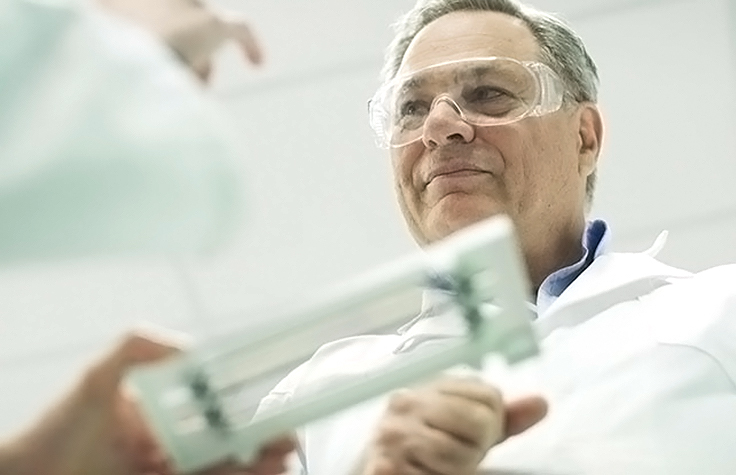Australia Genomics Center Scales its Services to Collaborate with Researchers Worldwide
Summary
Overview
The Deakin Genomics Centre wanted to offer and perform larger, more ambitious sequencing projects.
Challenge
Finding a high-throughput NGS system that could scale for larger sequencing projects and support diverse applications.
Solution
Professor Chris Austin and his team chose the NovaSeq 6000 System.
Benefits
The NovaSeq 6000 System is supporting Deakin University research and the Centre’s growth as a genomics hub, attracting interest from international collaborators.
Introduction
Chris Austin, PhD established the Deakin Genomics Centre in late 2017.1 At the beginning, it had a MiSeq™ System to support sequencing projects. The MiSeq System was used initially for microbial sequencing and shallow genome skimming. Soon, the Deakin Genomics Centre was receiving requests for larger, more ambitious projects that were beyond the capabilities of the MiSeq System. They began outsourcing sequencing to service providers with HiSeq™ Systems. While the data quality was good, it was an expensive option and turnaround times were long.
“We realized it would be better to purchase a high-throughput next-generation sequencing (NGS) system that could scale up for larger sequencing projects," Professor Austin said. “We also needed a system that could support diverse applications, including targeted, whole-genome sequencing (WGS), whole-exome sequencing (WES), and RNA-Seq. We received excellent support from Illumina with the MiSeq System. That gave us the confidence to choose the NovaSeq 6000 System.”


Offering More Than High-Throughput Sequencing
The NovaSeq 6000 System has done more than just enhance the research capabilities at Deakin University. According to Larry Croft, Associate Professor of Genomics and Manager of the Deakin Genomics Centre, “It has enabled us to build NGS into our teaching program. Today, our undergraduate and graduate students can come into the lab and learn how to perform library prep. They might not be pressing all the buttons, but they can see what the NovaSeq 6000 System is capable of and understand the whole concept of NGS and genomics.”
The NovaSeq 6000 System also supports the growth of the Deakin Genomics Centre as a genomics hub. “We have the only NovaSeq 6000 System outside of a major Australian city," Professor Austin said. "It’s become a valuable platform for Deakin researchers and an important asset for attracting interest from international collaborators and engaging research partners. In addition to partnering with us on genomics, they are sending their students and staff to Deakin University for training. It’s one more way we’re benefiting from this new infrastructure and the presence of the NovaSeq 6000 System."
Accelerating Research at Deakin University and Worldwide
With the NovaSeq 6000 System, the Deakin Genomics Centre is performing sequencing at scale. “We can do more than just genome assembly,” Professor Austin added. “We can perform WGS on samples of thousands of different individuals simultaneously or perform shallow skim sequencing to support selective breeding and evolution studies. It’s versatile, enabling us to perform RNA-Seq as well.”
"We can perform WGS on samples of thousands of different individuals simultaneously or perform shallow skim sequencing to support selective breeding and evolution studies."
The easy-to-use system enabled new staff to learn how to operate it quickly. “Library prep is also fast and its throughput is phenomenal," Associate Professor Croft said. "In two days, it can produce almost four terabytes of data on just one flow cell. Theoretically, we could produce eight terabytes of data every two days. That’s a massive change in our capacity. Instead of sequencing one genome, we can consider sequencing hundreds or even 1000s of genomes simultaneously.”
Associate Professor Croft likes the flexibility that the system offers to run several projects at a time. "We can load samples for many different projects on four different flow cell lanes,” Associate Professor Croft added. “On one run we could have mixtures for transcriptome sequencing and genome sequencing, with samples of different fragment sizes.”
Lower Sequencing Costs Attracts More Projects
The NovaSeq 6000 System has reduced sequencing costs at the Deakin Genomics Centre dramatically. “It has spurred new possibilities for using sequencing,” Associate Professor Croft said. “After having the NovaSeq 6000 System for a year, we have 90 separate projects ongoing. By next year, we hope to have 200—300 sequencing projects. We haven’t gotten close to meeting the capacity of the NovaSeq 6000 System to generate data. We’re making sure that we have the laboratory infrastructure, particularly bioinformatics people to handle that growth. It’s going to be awhile before we grow out of the NovaSeq 6000 System.
Supporting New Research
According to Professor Austin, “The NovaSeq 6000 System creates and supports so many new research opportunities. We’re answering important questions and finding answers to critical problems that might not otherwise be solved. Without it our research would be fairly pedestrian. We’d be performing fewer projects on a much smaller scale.”
Read more about these studies:
Deakin Genomics iCommunity article
Learn more about the systems mentioned in this case study:
References:
- Deakin Genomics Centre. Deakin University. www.deakin.edu.au/life-environmental-sciences/facilities/deakin-genomics-centre. Accessed April 2, 2019.
